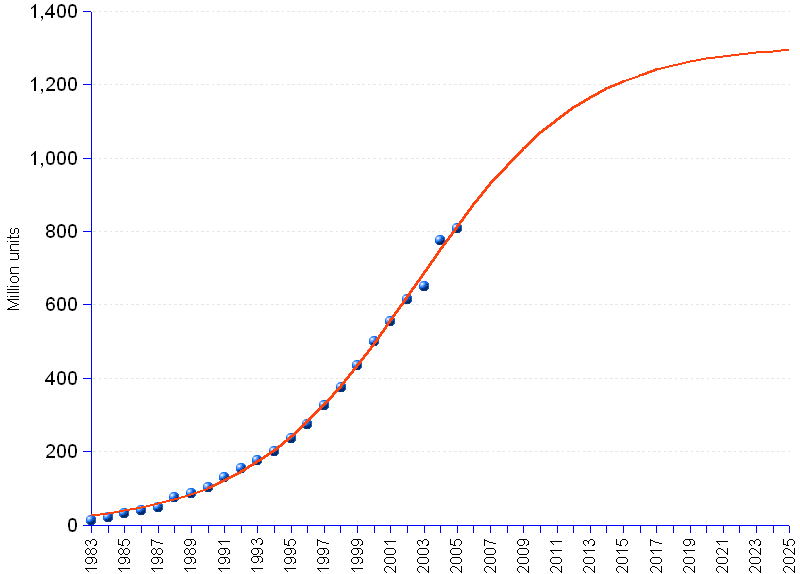

The chart shows the number of personal computers (PC's) in the world, both historical data (blue dots) from the ITU (International Telecommunications Union), and areppim forecast until 2025 (red S-shaped line).
According to the forecast model, the total number of PC's might reach a saturation volume of 1.3 billion, equivalent to about 1 PC for every 4 adults (15 year and older), by 2027. Growth has been exponential until 2002-2003. After this inflexion point, it decelerated, approaching the plateau by 2020.
Given the lack of data for personal computers on the national level, ITU stopped releasing related data after 2005, and this indicator was deleted from the official millennium development goals indicators. According to a report by Forrester Research, there were over one billion PCs in use worldwide by the end of 2008, and it is estimated that there will be more than two billion PCs in use by 2015. However, the exact number of personal computers currently in use remains a rough estimate.
Rumor has it that Olsen, the technologist and founder of DEC, suggested in 1977 that "there is no reason anyone would want a computer at home". He actually believed this — we heard him making a derogatory comment about PCs in a cafeteria meeting in 1983. But he was quite wrong. Since the launching of the IBM-PC in 1981, personal computers became ubiquitous, numbering 808 million in 2005, becoming a trivial tool at school, in the office or at home.
For more than a decade, analysts have predicted the downfall of the PC, condemned to obsolescence by other devices, such as mobile telephones endowed with loads of memory and computing functionality or a number of substitute gadgets like Amazon's Kindle. This did not happen yet, even though the very concept of PC is blurred by its numerous avatars — are desktops, laptops, netbooks, tablets or high-range smartphones the same product, or distinct ones? Whatever the answer, it seems that PC attained its full maturity as a product, and its growth will be a function of plain replacement, as suggested by areppim's forecast.
The latter uses a logistic growth function based on ITU series, two key parameters being a slope coefficient calculated by the least squares procedure and a saturation point estimated by bootstrapping. It is hard to determine the extent to which the model is impacted by the initial data point being in 1983. This cannot truly be considered as the birthday of the PC, since it is known that a sizable number of personal computers (such brands as Apple, Commodore, Atari and Tandy) had already been sold during the 1970's.
Personal Computers | ||
Year | Number of Personal Computers | |
Actual | Forecast ¹ | |
| 1983 | 12.6 | 13 |
| 1984 | 19.8 | 16 |
| 1985 | 30.4 | 19 |
| 1986 | 38.4 | 24 |
| 1987 | 47.5 | 30 |
| 1988 | 74.0 | 37 |
| 1989 | 86.3 | 46 |
| 1990 | 101.0 | 56 |
| 1991 | 130 | 69 |
| 1992 | 155 | 85 |
| 1993 | 175 | 105 |
| 1994 | 200 | 128 |
| 1995 | 235 | 155 |
| 1996 | 275 | 188 |
| 1997 | 325 | 226 |
| 1998 | 375 | 270 |
| 1999 | 435 | 320 |
| 2000 | 500 | 376 |
| 2001 | 555 | 438 |
| 2002 | 615 | 504 |
| 2003 | 650 | 573 |
| 2004 | 775 | 645 |
| 2005 | 808 | 716 |
| 2006 | 787 | |
| 2007 | 854 | |
| 2008 | 917 | |
| 2009 | 974 | |
| 2010 | 1,026 | |
| 2011 | 1,072 | |
| 2012 | 1,112 | |
| 2013 | 1,146 | |
| 2014 | 1,175 | |
| 2015 | 1,199 | |
| 2016 | 1,220 | |
| 2017 | 1,236 | |
| 2018 | 1,250 | |
| 2019 | 1,262 | |
| 2020 | 1,271 | |
| 2021 | 1,278 | |
| 2022 | 1,285 | |
| 2023 | 1,289 | |
| 2024 | 1,294 | |
| 2025 | 1,297 | |
| ¹ Logistic growth function | ||
Source: ITU International Telecommunications Union